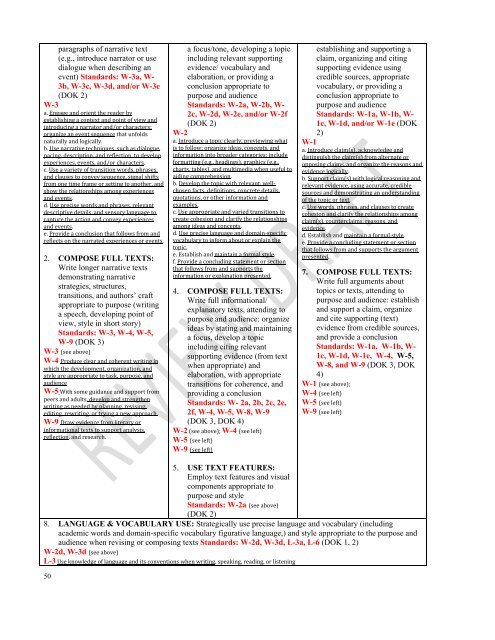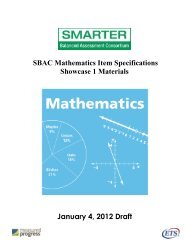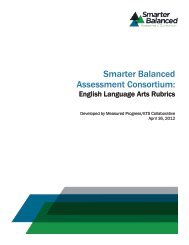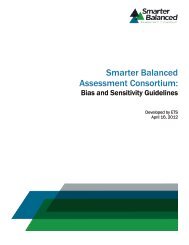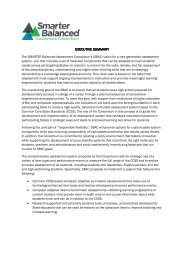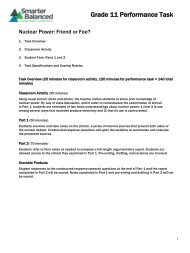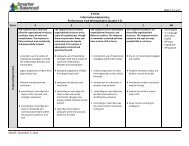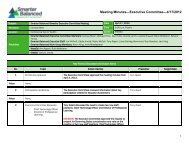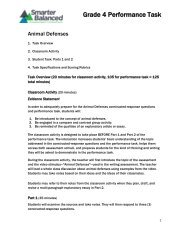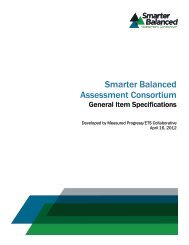Content Specifications for the Summative Assessment of the ...
Content Specifications for the Summative Assessment of the ...
Content Specifications for the Summative Assessment of the ...
Create successful ePaper yourself
Turn your PDF publications into a flip-book with our unique Google optimized e-Paper software.
paragraphs <strong>of</strong> narrative text<br />
(e.g., introduce narrator or use<br />
dialogue when describing an<br />
event) Standards: W-3a, W-<br />
3b, W-3c, W-3d, and/or W-3e<br />
(DOK 2)<br />
W-3<br />
a. Engage and orient <strong>the</strong> reader by<br />
establishing a context and point <strong>of</strong> view and<br />
introducing a narrator and/or characters;<br />
organize an event sequence that unfolds<br />
naturally and logically.<br />
b. Use narrative techniques, such as dialogue,<br />
pacing, description, and reflection, to develop<br />
experiences, events, and/or characters.<br />
c. Use a variety <strong>of</strong> transition words, phrases,<br />
and clauses to convey sequence, signal shifts<br />
from one time frame or setting to ano<strong>the</strong>r, and<br />
show <strong>the</strong> relationships among experiences<br />
and events.<br />
d. Use precise words and phrases, relevant<br />
descriptive details, and sensory language to<br />
capture <strong>the</strong> action and convey experiences<br />
and events.<br />
e. Provide a conclusion that follows from and<br />
reflects on <strong>the</strong> narrated experiences or events.<br />
2. COMPOSE FULL TEXTS:<br />
Write longer narrative texts<br />
demonstrating narrative<br />
strategies, structures,<br />
transitions, and authors’ craft<br />
appropriate to purpose (writing<br />
a speech, developing point <strong>of</strong><br />
view, style in short story)<br />
Standards: W-3, W-4, W-5,<br />
W-9 (DOK 3)<br />
W-3 (see above)<br />
W-4 Produce clear and coherent writing in<br />
which <strong>the</strong> development, organization, and<br />
style are appropriate to task, purpose, and<br />
audience<br />
W-5 With some guidance and support from<br />
peers and adults, develop and streng<strong>the</strong>n<br />
writing as needed by planning, revising,<br />
editing, rewriting, or trying a new approach.<br />
W-9 Draw evidence from literary or<br />
in<strong>for</strong>mational texts to support analysis,<br />
reflection, and research.<br />
a focus/tone, developing a topic<br />
including relevant supporting<br />
evidence/ vocabulary and<br />
elaboration, or providing a<br />
conclusion appropriate to<br />
purpose and audience<br />
Standards: W-2a, W-2b, W-<br />
2c, W-2d, W-2e, and/or W-2f<br />
(DOK 2)<br />
W-2<br />
a. Introduce a topic clearly, previewing what<br />
is to follow; organize ideas, concepts, and<br />
in<strong>for</strong>mation into broader categories; include<br />
<strong>for</strong>matting (e.g., headings), graphics (e.g.,<br />
charts, tables), and multimedia when useful to<br />
aiding comprehension.<br />
b. Develop <strong>the</strong> topic with relevant, wellchosen<br />
facts, definitions, concrete details,<br />
quotations, or o<strong>the</strong>r in<strong>for</strong>mation and<br />
examples.<br />
c. Use appropriate and varied transitions to<br />
create cohesion and clarify <strong>the</strong> relationships<br />
among ideas and concepts.<br />
d. Use precise language and domain‐specific<br />
vocabulary to in<strong>for</strong>m about or explain <strong>the</strong><br />
topic.<br />
e. Establish and maintain a <strong>for</strong>mal style.<br />
f. Provide a concluding statement or section<br />
that follows from and supports <strong>the</strong><br />
in<strong>for</strong>mation or explanation presented.<br />
4. COMPOSE FULL TEXTS:<br />
Write full in<strong>for</strong>mational/<br />
explanatory texts, attending to<br />
purpose and audience: organize<br />
ideas by stating and maintaining<br />
a focus, develop a topic<br />
including citing relevant<br />
supporting evidence (from text<br />
when appropriate) and<br />
elaboration, with appropriate<br />
transitions <strong>for</strong> coherence, and<br />
providing a conclusion<br />
Standards: W- 2a, 2b, 2c, 2e,<br />
2f, W-4, W-5, W-8, W-9<br />
(DOK 3, DOK 4)<br />
W-2 (see above); W-4 (see left)<br />
W-5 (see left)<br />
W-9 (see left)<br />
establishing and supporting a<br />
claim, organizing and citing<br />
supporting evidence using<br />
credible sources, appropriate<br />
vocabulary, or providing a<br />
conclusion appropriate to<br />
purpose and audience<br />
Standards: W-1a, W-1b, W-<br />
1c, W-1d, and/or W-1e (DOK<br />
2)<br />
W-1<br />
a. Introduce claim(s), acknowledge and<br />
distinguish <strong>the</strong> claim(s) from alternate or<br />
opposing claims, and organize <strong>the</strong> reasons and<br />
evidence logically.<br />
b. Support claim(s) with logical reasoning and<br />
relevant evidence, using accurate, credible<br />
sources and demonstrating an understanding<br />
<strong>of</strong> <strong>the</strong> topic or text.<br />
c. Use words, phrases, and clauses to create<br />
cohesion and clarify <strong>the</strong> relationships among<br />
claim(s), counterclaims, reasons, and<br />
evidence.<br />
d. Establish and maintain a <strong>for</strong>mal style.<br />
e. Provide a concluding statement or section<br />
that follows from and supports <strong>the</strong> argument<br />
presented.<br />
7. COMPOSE FULL TEXTS:<br />
Write full arguments about<br />
topics or texts, attending to<br />
purpose and audience: establish<br />
and support a claim, organize<br />
and cite supporting (text)<br />
evidence from credible sources,<br />
and provide a conclusion<br />
Standards: W-1a, W-1b, W-<br />
1c, W-1d, W-1e, W-4, W-5,<br />
W-8, and W-9 (DOK 3, DOK<br />
4)<br />
W-1 (see above);<br />
W-4 (see left)<br />
W-5 (see left)<br />
W-9 (see left)<br />
5. USE TEXT FEATURES:<br />
Employ text features and visual<br />
components appropriate to<br />
purpose and style<br />
Standards: W-2a (see above)<br />
(DOK 2)<br />
8. LANGUAGE & VOCABULARY USE: Strategically use precise language and vocabulary (including<br />
academic words and domain-specific vocabulary figurative language,) and style appropriate to <strong>the</strong> purpose and<br />
audience when revising or composing texts Standards: W-2d, W-3d, L-3a, L-6 (DOK 1, 2)<br />
W-2d, W-3d (see above)<br />
L-3 Use knowledge <strong>of</strong> language and its conventions when writing, speaking, reading, or listening<br />
50


